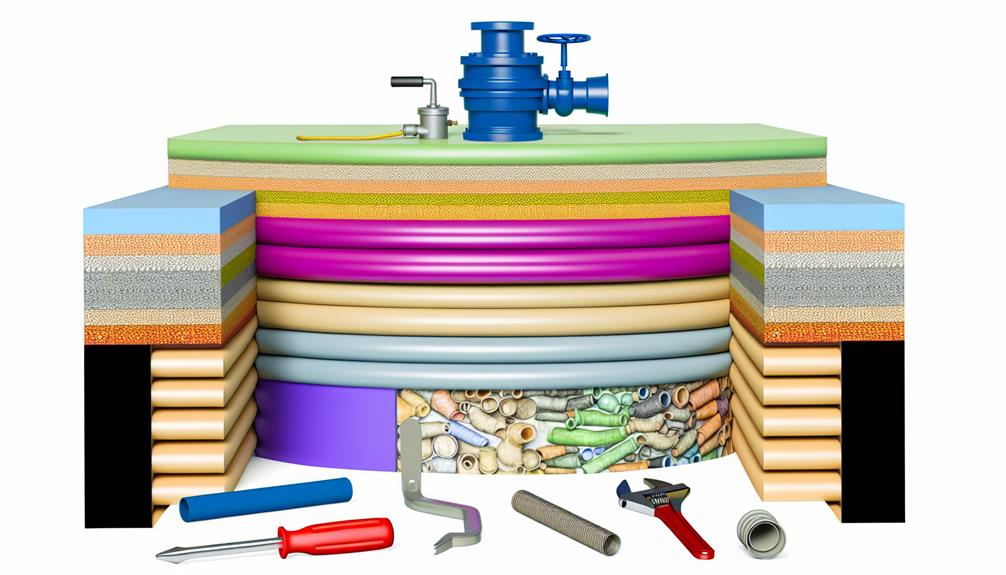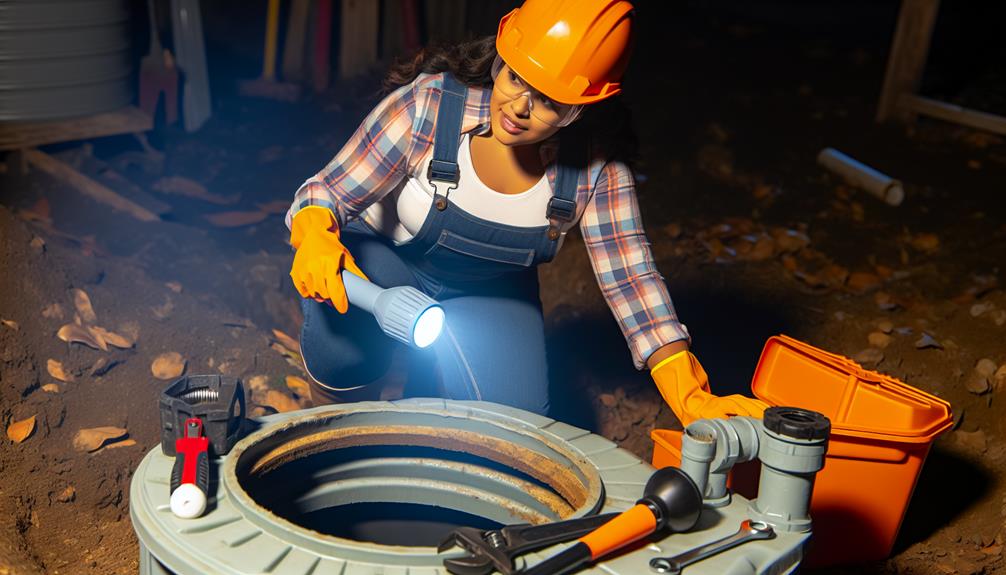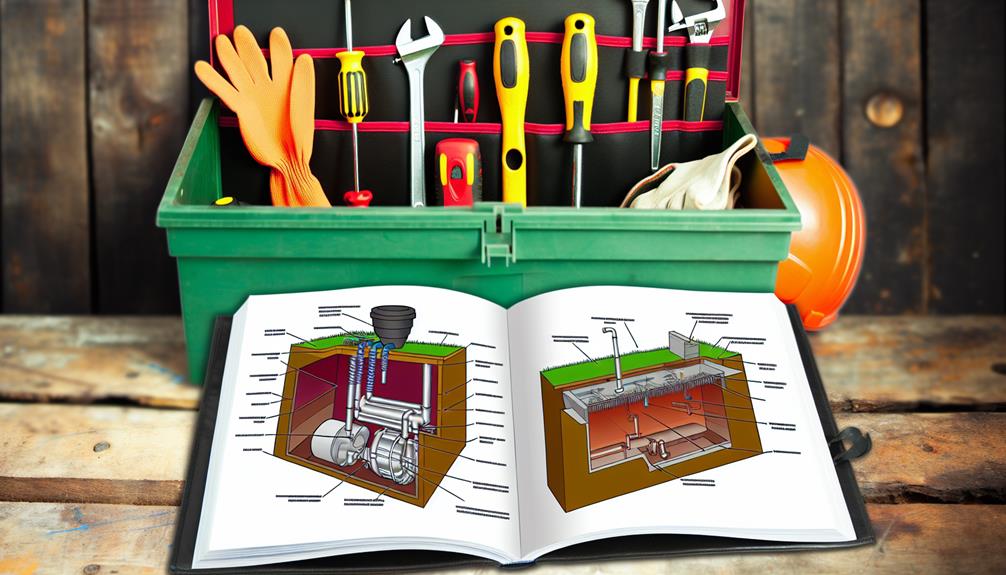Discover how to protect your septic system from breakdown with...
Read MoreYou & Your Septic Tank
7 DIY Solutions for Septic Tank Pumping Issues
Our professional septic service team offers comprehensive septic tank pumping services to keep your system running smoothly. Get a FREE Quote Today.

7 DIY Solutions for Septic Tank Pumping Issues
Just by coincidence, you’re facing septic tank pumping issues at the same time we’ve compiled these seven DIY solutions to tackle them.
You might think that these problems are beyond your control, but, in fact, they’re manageable with a little know-how and elbow grease.
By leaning on your own capabilities, you could save a hefty sum of money on professional services and gain greater control over your household maintenance.
So, why not take a journey through these practical, cost-effective strategies that could potentially make your septic tank problems a thing of the past?
Key Takeaways
- Understanding the factors that influence septic tank pumping frequency is crucial for effective maintenance.
- Identifying common septic tank issues, such as slow drains and foul odors, can help prevent system failures.
- Frequent septic system failures can be caused by inadequate tank capacity and poor installation.
- Prevention of tank issues through managing water usage, regular inspections, and proper waste disposal practices is essential for maintaining a healthy septic system.
Understanding Septic Tank Pumping Basics

Before diving into the intricacies of septic tank pumping, it’s crucial to grasp the basic principles that govern this essential maintenance process.
One key principle is the pumping frequency. It’s not a one-size-fits-all situation. Various factors influence the timing, including the number of people in your household, the amount of wastewater generated, and the volume of solids in the wastewater.
Now, let’s talk about septic capacity. It’s the volume your tank can hold before it needs pumping. Your septic capacity directly affects the frequency of pumping. If you’ve got a small tank serving a large family, you’ll find yourself needing to pump more often than a single person with a larger tank. It’s a delicate balance that needs careful consideration.
Identifying Common Septic Tank Issues
You’ve got the hang of the basics, now let’s tackle common septic tank issues.
Knowing what signs to look for can help you identify septic tank symptoms early and prevent frequent system failures.
We’ll also discuss ways to prevent these issues from cropping up in the first place.
Recognizing Septic Tank Symptoms
Often, it’s the subtle signs that alert you to potential septic tank issues, such as slow drains, foul odors, or lush patches of grass over the tank. These symptoms might indicate a problem with your septic system installation or tank location.
Here’s a quick reference table to help you recognize these signs:
| Symptoms | Possible Issues |
|---|---|
| Slow drains | Blocked or damaged pipes |
| Foul odors | Full or failing septic tank |
| Lush patches of grass | Overloaded or leaking septic tank |
Frequent Septic System Failures
If you’ve noticed any of the symptoms mentioned above, you may be dealing with one of the common septic tank issues that frequently lead to system failures. One such problem could stem from an inadequate tank capacity. If your tank is too small for the amount of wastewater you’re producing, it won’t be able to function correctly. You’ll need to regularly check the tank’s level and have it pumped more frequently to prevent backups or overflows.
Issues could also arise from poor system installation. If the system isn’t installed correctly, it can lead to a host of problems, including leaks, blockages, and even system failure. Always ensure you work with a reputable installer who understands the intricacies of septic system installations.
Prevention of Tank Issues
Preventing septic tank issues begins with understanding and identifying the most common problems that can occur. One such issue is exceeding the tank capacity. You must be aware of your tank’s size and manage your water usage accordingly. Overloading the system can lead to backups and potential damage.
Odor control is another important aspect of prevention. Unpleasant smells can signal an impending issue. Regular inspections and maintenance are essential to ensure that your septic system is functioning properly and to address any issues promptly.
Always keep in mind, prevention is better than costly repairs. By keeping tabs on your tank capacity and maintaining good odor control, you’ll be on your way to a trouble-free septic system.
DIY Solution 1: Clearing Drain Field Pipes
Let’s kick off our first DIY solution by understanding your septic system’s drain field pipes. These pipes play a critical role in your system’s functionality and knowing how to clean them can save you a lot of hassle.
We’ll also discuss ways to prevent pipe clogs, ensuring your septic system runs smoothly for years to come.
Understanding Drain Field Pipes
Before diving into DIY solutions, it’s crucial that you have a solid understanding of how drain field pipes work in your septic system. Drain field construction begins with a network of perforated pipes laid in gravel-filled trenches. These pipes distribute the treated wastewater evenly throughout the drain field.
The pipe material selection is vital as well. PVC is commonly used due to its resistance to corrosion and decay. However, different types of soil and conditions may require more robust materials.
When these pipes get clogged, they prevent the septic system from draining properly. Solving such issues yourself can save time and money. But remember, understanding the basics of your system’s pipes is the first step in addressing any problems.
Drain Field Pipe Cleaning
Now that you’ve grasped the importance of drain field pipes and their role in your septic system, we can explore how to effectively clean these pipes as a DIY solution to maintain your system’s functionality.
The pipe material selection is crucial for the efficiency and longevity of your system. Opt for sturdy, non-corrosive materials like PVC that can withstand the corrosive nature of waste.
For cleaning, you’ll need a high-pressure water jetter to clear any blockages.
Careful trench construction techniques are key to prevent pipe damage. Dig trenches with a gentle slope to facilitate wastewater flow.
If a pipe gets blocked, locate the cleanout plug, remove it, and insert the jetter. Flush the lines until the blockage is cleared, then replace the plug.
Always protect yourself with gloves and eye protection.
Prevention of Pipe Clogs
Regularly inspecting and clearing your drain field pipes can significantly reduce the risk of clogs, ensuring smooth operation of your septic system. Employing clog detection methods, such as visual inspection or using a plumber’s snake, helps identify potential blockages early. It’s crucial to address any signs of clogs immediately to prevent backup and damage.
As part of your DIY maintenance, root intrusion prevention is a must. Roots from nearby trees can infiltrate your pipes, causing costly clogs. Regularly check your drain field for plant growth. If you notice roots near your pipes, take action immediately. You can use root-killing chemicals or hire a professional to remove them. Remember, prevention is always easier and cheaper than repair.
DIY Solution 2: Using Bacterial Additives
Harnessing the power of bacterial additives can be your septic tank’s best line of defense against clogging and other common issues. Understanding the bacterial benefits is key to maintaining a healthy, functioning septic system. These beneficial bacteria break down solid waste, reducing the risk of build-up and ensuing problems. Over time, the use of household chemicals can decrease the natural bacteria in your tank. But by introducing bacterial additives, you’re actively replenishing these helpful organisms.
Additive selection is just as important. You’ll come across two main types: chemical and biological. Chemical additives can sometimes do more harm than good, corroding your septic tank and polluting ground water. It’s better to stick with biological additives, which are essentially high-concentration bacterial solutions. They’re safe, eco-friendly, and highly effective in maintaining your septic tank health.
Using bacterial additives is a simple process. You just pour them down the toilet and flush. The additives then travel to your septic tank, where they start working immediately. This DIY solution is an effortless, cost-effective method of sustaining your septic system, reducing the need for frequent, expensive pump-outs.
DIY Solution 3: Regular Septic Tank Inspection

Keeping a keen eye on your septic tank through regular inspections is another DIY solution that can save you from costly repairs in the long run. You’ll be able to spot potential problems early on and take immediate action. Inspection frequency and the right inspection tools are crucial in this process.
The inspection frequency depends on various factors such as the size of the tank, the number of occupants in your home, and the amount of wastewater generated. As a rule of thumb, inspect your septic tank at least once a year. However, if your household generates a lot of waste, you might need to inspect it more frequently.
When it comes to inspection tools, a simple flashlight can be useful for checking the general condition of the tank. For a more thorough inspection, you might need a septic tank inspection mirror or a septic tank probe.
| Inspection Frequency | Inspection Tools |
|---|---|
| Once a year | Flashlight |
| More frequently for high waste generation | Septic tank inspection mirror |
| Based on the size of the tank and the number of occupants | Septic tank probe |
DIY Solution 4: Proper Waste Disposal
An essential part of maintaining your septic tank lies in the proper disposal of waste. It’s not just about what goes into the tank, but also how you handle and segregate your waste. Here, waste segregation practices and composting organic waste play crucial roles.
- Start by segregating your waste. Implement waste segregation practices at home. Separate your waste into biodegradable, non-biodegradable, and recyclable materials. This reduces the load on your septic tank and makes waste management easier.
- Compost your organic waste. Composting organic waste is an excellent way to reduce the amount of waste that goes into your septic system. It’s also a great source of nutrient-rich soil for your garden.
- Avoid flushing non-degradable items. Items like wipes, feminine hygiene products, and diapers should never be flushed down the toilet. They can cause serious damage to your septic system.
- Limit the use of harsh chemicals. These can kill the beneficial bacteria in your septic tank that help break down waste.
DIY Solution 5: Preventive Measures and Maintenance

Regularly scheduling septic tank inspections is a key component of preventive maintenance that can save you from potential costly repairs down the line. This strategy allows you to manage your tank capacity effectively and ensures you’re using septic friendly products.
Here’s a preventative maintenance schedule you can follow:
| Month | Action Item | Reason |
|---|---|---|
| Every 3rd | Inspect tank | Early issue detection |
| Every 6th | Pump out tank | Manage tank capacity |
| Monthly | Use septic friendly products | Protect system health |
| Annually | Professional assessment | Confirm system’s effectiveness |
| As Needed | Repair/Replace parts | Avoid system breakdown |
Remember, not all products are septic safe. You’ll want to use toilet paper and household cleaners that are labeled as septic friendly. They’re designed to break down easily in your system, reducing the chances of clogs or backups.
Tank capacity management is also crucial. Don’t wait until your septic tank is overflowing before you call for a pump-out. Schedule regular pump-outs based on your household size and water usage. By maintaining these preventive measures, you’ll keep your septic system in tip-top shape, saving you time, money, and stress in the long run.
Conclusion
You’ve learned the ropes, now it’s up to you. Don’t let septic tank issues put a dampener on your day. Embrace these DIY solutions, clearing pipes, using bacteria, conducting checks, disposing waste correctly and sticking to a strict maintenance schedule.
Remember, in this journey of home maintenance, every little bit counts. Your septic tank might be out of sight, but don’t let it be out of mind. After all, a well-maintained home is a happy home.
You may also like...
Why Are DIY Fixes Essential for Septic Tank Pumping?
Tap into the importance of DIY fixes for septic tank...
Read MoreUnveiling the Average Costs of Septic Tank Pumping
Master the mysteries of septic tank pumping costs and avoid...
Read More
The Best Septic Tank Pumping Services Near You

Answer Some Questions
Let us know about your needs so we can find you the right septic tank pros.

Get Quotes
We will put you in touch with the right septic tank pros for your job and location.

Hire Right
Compare quotes, message or call pros, and hire only when ready.



